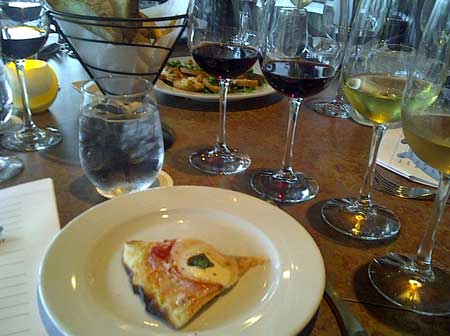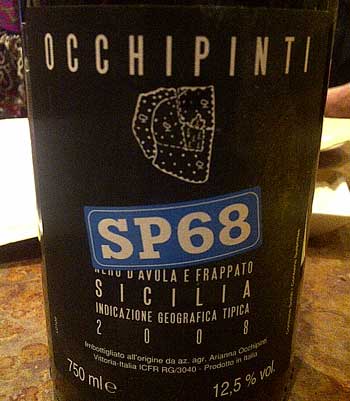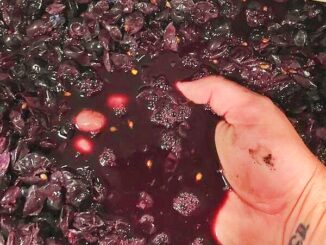What I Want to See in the Future of Texas’s Tex-Med Wines…
High quality and good value just like these wines even if I can’t remember the names of all the grapes!
Yesterday evening, Jeremy Parzen (www.dobianchi.com) came to my H-town’s Montrose neighborhood to do a guided tasting of wines from Italy and Sardinia at Tony and Jeff Vallone’s Caffe Bello. As Jeremy stood before the assembled group he introduced his wine selections. When he came to the evening’s second wine, Santadi Vermentino di Sardegna DOC “Villa Solais” 2009, he made a brief comment. And, I took his comment seriously, particularly the reference to Texas.
He said, “These are some of my favorite wines on the Vallones’ Caffe Bello wine list. But, another reason why I selected Vermentino to taste tonight is because we are having this wine tasting in Texas. One of the most talked about grapes now growing in Texas is Vermentino. It’s got its roots in and around Italy and Sardinia, but it also likes the hot Mediterranean-like weather in Texas, too.”
I agreed with Jeremy’s assessment: Texas Vermentino (check out Duchman Family Winery Vermentino), it’s really good stuff, as are many other Texas wines made from varieties of grapes that originate from countries that rim the deep azure Mediterranean Sea. More specifically, these countries are Italy, Sardinia, Southern France and Spain, and with a slight reach, I’ll even include Portugal, too. I coined a term over a decade ago when I called them our “Tex-Med” grape varieties that include Italian reds like Sangiovese, Aglianico and Nero d’Avola, and Vermentino, Muscato and Trebbiano as the whites.
Therefore, the tasting at Caffe Bello was a chance for me, along with the other tasters present, to see a glimpse of what the future of Texas wines might hold for us wine aficionados. These are definitely exciting times in the Texas wine experience as many of the aspects of the Tex-Med varietals are still in the state of flux. Not many disagree that these types of grapes can handle the warm Texas sun, but the issues that remain are how they will handle our soils, our on-again/off-again rains, and of most importance, how they will handle our notorious late spring frosts and freezes? These are questions that are yet to be answered. Answers to these and other questions will determine which Tex-Med grapes will be “keepers” a decade or more from now.
Jeremy lead us through a series of wines that were of good quality and value, and had one more characteristic property of Italian wines: they were crisp with acidity, a key to their food-friendly nature. These wines were all $40 or less a bottle on the Caffe Bello wine list. This is also an important factor to me as I feel that a good wine list needs to provide a quality entry level wine tasting experience at that price point.
The wines at the tasting included:
Vallone Sicilia Vino da Tavola Nero d”Avola (Interestingly, vinified as a white wine with juice immediately taken off the skins during winemaking). It offered a slight dry blush, medium body with fruit and citrus notes.
Santadi Vermentino di Sardegna DOC “Villa Solais” (Vermentino from Sardinia) was of deep yellow color, rich in vanilla, citrus and herbs. It was a bit more intense than its brethren from Texas of admittedly made from younger vinestock, and the Santadi was made in an older-worldly style than that used in Texas.
Vietta Barbera d’Alba “Tre Vigne” (Piemonte) and Tommasi Valpolicella DOC (Veneto) northern Italian favorites with bright red and dark fruit, minerally and earthy notes.
Care to guess what varieties of grapes are in Valpolicella wine? Ask nearly anybody you know and they will likely come up with some form of losers limp rather than offer even a suggestion. Well, the grapes are Corvina, Molinara and Rondinella….there! Stump your buds with that!
We closed with Volpia Chianti Classico DOCG and then my wife joined me and we assembled for dinner with Jeremy, his friends and family including cousin Marty, and food bloggers Joanne Witt (@FoodPrincess) and Chris Reid (@Houston_Foodie).
This offered me another chance to peer into the possible future of Texas wine when Jeremy ordered up a bottle of Occichipinti SP68 Nero d’Avola. Great red fluid drawn from the volcanic soils of a faraway vineyard and formulated by the native yeasts carried by the Mediterranean breeze that eventually settled on the grapes as they ripened in the hot Sicilian summer sun. I tweeted a picture of the bottle with a quick comment about my hopes for the future of Texas wine. In short order, I received a response in 140 character “Twitterese” from the winemaker at Brennan Vineyards in Comanche, Texas, who said, “We grow Nero d’Avola. Normally gets blended, but we did barrel some 2010 to make a varietal wine.”
Well, bring it on, man! I can’t wait to taste it. I will try to have enough so, at a future date, I can share some of this Texas-grown Nero d’Avola with Jeremy, who has enriched my life with his wine knowledge, passion for things Italian and his friendship.






Russ, thanks so much for being there. It was great to have you with us. I’m so glad you liked the Occhipinti. I LOVE that wine… And also glad you finally got to meet Cousin Marty and co.
See you soon in HTX.
abbraccio j